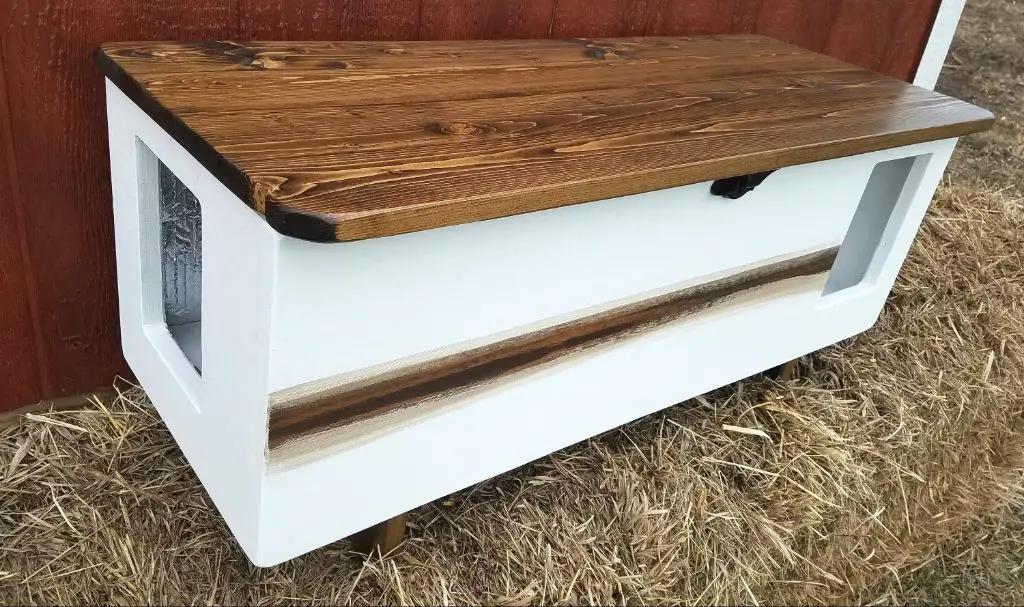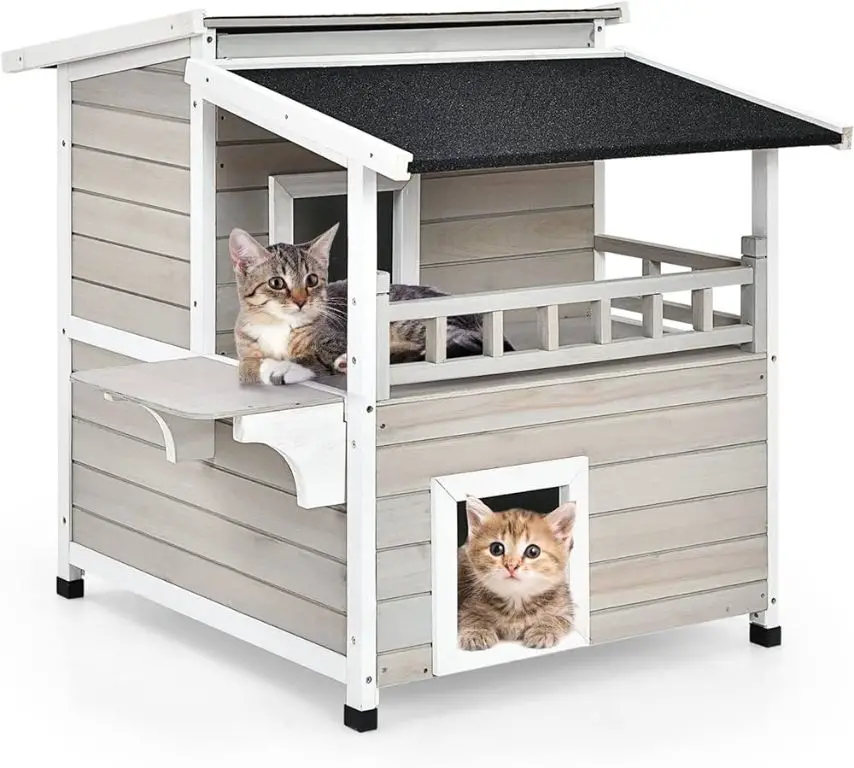Outdoor cats require shelter to protect them from the elements and provide a safe place to rest. An important consideration for outdoor cat shelters is whether they should have one or two doors. This article will examine the pros and cons of one vs. two door designs for outdoor cat houses to help cat owners decide what’s best for their feline friends.
Key questions to be addressed include:
- What are the benefits of a two door cat shelter?
- What are the drawbacks of having two doors?
- When is a one door design preferable?
- How do factors like heating, size and placement impact the door configuration?
By weighing these considerations, cat owners can make an informed decision when selecting or building an outdoor cat shelter.
Pros of Two Doors
Cat shelters with two doors provide several advantages compared to single door designs. As noted in this discussion on TheCatSite, having two entrances allows for a quick escape if another animal enters the shelter. Cats have a strong instinct to flee danger, so multiple exit points can be lifesaving. Additionally, when sharing a shelter, two doors reduce territorial disputes since each cat can have their own entrance and exit. As explained in Alley Cat Allies’ guide, two doors essentially create two distinct shelters in one structure.
Cons of Two Doors

While two doors provide more escape routes for cats, cat houses with two doors also have some drawbacks. One major downside is that two-door cat houses can be more difficult to heat effectively, especially in colder climates. The presence of two entryways means more opportunities for heated air to escape and cold drafts to enter the shelter (Source). This may require a higher-output heating source to maintain a comfortable temperature.
Related to the heating challenges, two-door cat shelters also tend to be more expensive than single entry models. Not only is a more powerful heating element likely needed, but the construction of a dual-entry design itself requires more materials and labor. The additional door must be properly framed, hinged, latched, etc. Sometimes a dividing wall is also used inside to separate the two entryways.
Space constraints may also make a two-door shelter less feasible. Having two doors side-by-side consumes more floor area than a single centered doorway. The shelter needs ample room around both doors to allow easy comings and goings. This may limit placement options in smaller yards (Source).
One Door Designs
Single door cat houses can work well for cats if designed properly. The main advantage of a one door design is the ability to retain heat better than a two door model. Cats like small, enclosed spaces so having just one entrance helps keep the inside warmer (https://www.neighborhoodcats.org/how-to-tnr/colony-care/feral-cat-winter-shelter).
When using a one door design, it’s important to consider proper placement so the cat has quick escape routes. Putting the doorway facing a wall or corner limits escape options if another animal approaches. It’s better to face the opening towards an open area so the cat can run in multiple directions if needed (https://homeandroost.co.uk/blog/how-to-place-an-outdoor-cat-shelter/).
The doorway should be just big enough for a cat, around 6-8 inches wide. This helps hold in warmth while allowing entry and exit. Consider hanging a flap over the opening to provide additional insulation.
Since a one door design has limited escape routes, use extra weatherproofing like treated wood or waterproof liners. The cat will rely solely on the shelter for protection so it must stand up to all weather conditions.
Finally, provide plenty of dry, fresh straw or hay inside for insulation. And elevate the house several inches off the ground so it stays dry underneath (https://www.alleycat.org/community-cat-care/providing-shelter/).
Two Door Designs
Having two doors is highly recommended for outdoor cat houses. This allows the cat to have multiple entry and exit points, enabling them to escape quickly if threatened (https://homeandroost.co.uk/blog/how-to-place-an-outdoor-cat-shelter/).
The doors should be placed on opposite sides or ends of the shelter, providing easy access no matter which direction the cat is coming from. Make sure the doors are big enough for the cat to comfortably enter and exit. The recommended size is around 8 inches wide by 10 inches high (https://www.wikihow.com/Build-a-Cat-House).
For added protection, the doors can be offset or staggered so they don’t directly line up. This prevents wind or rain from blowing straight through. Flaps over the doorways also help shield the interior from the elements.
The floor plan inside should allow clear paths between the doors without obstruction. Place bedding and other items out of high traffic areas so the cat isn’t startled or trapped when entering or exiting through the doors.
Heated vs Unheated
When it comes to outdoor cat houses, one of the biggest decisions is whether to get a heated or unheated model. Both have their pros and cons.
Heated cat houses provide extra warmth and comfort for cats in cold weather climates. Most use a safe, low-wattage heating pad or panel powered by electricity or batteries to maintain a comfortable temperature inside the house. According to The Kitty Tube, heated cat houses are ideal for temperatures below 45°F.

Some key pros of heated cat houses include:
- Provide consistent warmth for outdoor cats in cold weather
- Allow cats a place to warm up on frigid days and nights
- Made of insulated, draft-blocking materials to retain heat
- Offer a heated refuge when regular houses become too cold
Potential cons of heated cat houses include:
- More expensive initially than unheated houses
- Require electricity access or battery changes to power the heating element
- Can overheat in warmer weather if not adjustable
- Heating elements may malfunction over time
Unheated cat houses are a simpler, more affordable option suitable for moderate climates. According to Amazon, unheated houses work well for temperatures above 45°F. Key pros include:
- Lower cost than heated models
- Don’t require electricity or batteries
- Often lighter weight and more portable
- Provide basic shelter in milder weather
Potential cons of unheated houses include:
- May not be warm enough for cats in colder climates
- Lack a heat source for frigid temperatures
- Less insulation and draft protection than heated models
- Can’t actively warm a cat up like a heated house
In the end, choosing between heated and unheated depends on your cat’s needs and your local weather conditions. Heated houses provide maximum cold weather protection while unheated versions offer an affordable basic shelter option.
Materials
The best material to use for insulating outdoor cat shelters is straw. Straw provides excellent insulation to retain heat and keep cats warm in cold temperatures. Straw is hollow and allows for air pockets that prevent heat loss and block drafts. It also absorbs moisture and prevents sogginess. Straw is lighter than hay, making it easier for cats to arrange and burrow into for nesting (Blue Mountain Hay).

Another good insulating material for outdoor cat houses is cedar shavings. Cedar has natural aromatic oils that have a pleasant smell and repel pests like fleas. The shavings allow for airflow while insulating the shelter (Alley Cat Allies). Aspen and pine shavings can also be used but may not repel insects as effectively.
Hay and fabrics like blankets should be avoided as primary insulating materials. Hay retains more moisture than straw, which can lead to mold and mildew. Blankets can become damp and get dusty or dirty over time. The best use for these materials is potentially as secondary liners over quality straw bedding.
Size
When choosing the size for a cat house, it’s important to consider how many cats will be using it. According to Alley Cat Allies, a good size for a single cat is about 2 feet by 3 feet and at least 18 inches high. This provides enough room for the cat to turn around and curl up comfortably.
For multiple cats, Bideawee recommends a larger size of 24” x 24” x 18”, which can fit 3-4 cats. More space allows cats to spread out and retain body heat more effectively. Larger shelters are preferable for community cats, though keep in mind that bigger isn’t always better since heat disperses quickly.
The dimensions can be adjusted based on your specific needs, but make sure to provide adequate room for the number of cats the house will serve. Proper sizing will keep them warm and comfortable.
Placement
Proper placement of an outdoor cat shelter is critical for providing a warm, dry, and safe space for cats. According to Home & Roost, it’s best to place the shelter in a sunny spot, as direct sunlight will help warm the interior on cold days. A sunny location can increase the internal temperature by up to 10 degrees. South or southeast facing spots are ideal for maximizing sun exposure.

The Neighborhood Cats organization recommends positioning two shelters side-by-side about 1.5 feet apart, with the doors facing each other. You can cover the gap between with a board to block wind and rain. Having two shelters allows multiple cats to have their own space.
In addition to sun exposure, also ensure the shelter is elevated and well-drained to avoid water pooling. Place it in a discreet area, like under bushes or a porch, so cats feel hidden and secure. Avoid high-traffic spots that may startle them. If elevating off the ground, place straw inside for insulation.
For winter weather, prioritize protection from the elements over sunshine. Place the shelter in a covered spot, shielded from wind, rain, and snow. Garages, porches, and under decks work well. Make sure outdoor electrical outlets are GFCI protected if heated products are used.
Conclusion
In summary, there are pros and cons to having a cat house with one or two doors. Single door houses are simpler and cheaper, while two door houses allow for more escape routes. Placement and size are important factors as well – cat houses should be set in a quiet location protected from the elements and large enough for the cat to move around. Heated houses help cats stay warm in winter. The optimal cat house has adequate insulation, weatherproofing, and shade in the summer. High quality materials like wood and sturdy plastic last longer than cardboard. The perfect cat house provides cats with a safe space to rest and regulate their body temperature year-round.
When designing or selecting a cat house, consider your cat’s needs and preferences as well as your climate and budget. Focus on durability, insulation, protection from wind and rain, and sufficient interior space. Monitor your cat’s use of the house and make adjustments to increase comfort and usability. With an appropriately built and located cat shelter, outdoor and feral cats in your area can enjoy healthier lives.
